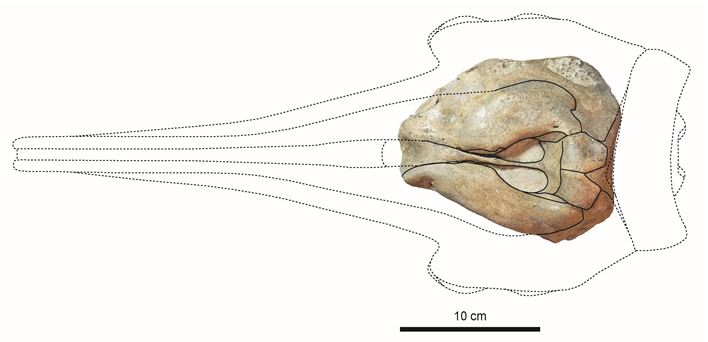Waseda researchers discover the world's oldest true dolphin species – rewrite the known fossil record

Diagram of the ancient dolphin's asymmetrical skull (by Mizuki Murakami)
In an article published in the “Journal of Vertebrate Paleontology”, Waseda Department of Earth Sciences researchers (lead author Mizuki Murakami) conclude that the specimen, which was originally categorized in 1977 as Stenella kabatensis, actually belongs to the Eodelphis kabatensis species.
This means that true dolphins existed 2 to 7 million years earlier than had been previously suggested by fossil records, and aligns with the results of molecular studies.
This work also includes the most comprehensive analysis yet of the relationships within the group of marine mammals that encompasses toothed whales such as orcas and sperm whales.
In another study, Murakami and a team of researchers also described the oldest known dolphin fossil with an asymmetrical skull, and created a new simulation of their evolution.
It has been accepted theory that dolphin ancestors earlier than 10 million years ago all had symmetrical skulls, and that asymmetry was the result of subsequent evolution. This study suggests a different evolutionary path for the marine mammals.
Media Contact
All latest news from the category: Earth Sciences
Earth Sciences (also referred to as Geosciences), which deals with basic issues surrounding our planet, plays a vital role in the area of energy and raw materials supply.
Earth Sciences comprises subjects such as geology, geography, geological informatics, paleontology, mineralogy, petrography, crystallography, geophysics, geodesy, glaciology, cartography, photogrammetry, meteorology and seismology, early-warning systems, earthquake research and polar research.
Newest articles

Sea slugs inspire highly stretchable biomedical sensor
USC Viterbi School of Engineering researcher Hangbo Zhao presents findings on highly stretchable and customizable microneedles for application in fields including neuroscience, tissue engineering, and wearable bioelectronics. The revolution in…

Twisting and binding matter waves with photons in a cavity
Precisely measuring the energy states of individual atoms has been a historical challenge for physicists due to atomic recoil. When an atom interacts with a photon, the atom “recoils” in…

Nanotubes, nanoparticles, and antibodies detect tiny amounts of fentanyl
New sensor is six orders of magnitude more sensitive than the next best thing. A research team at Pitt led by Alexander Star, a chemistry professor in the Kenneth P. Dietrich…





















